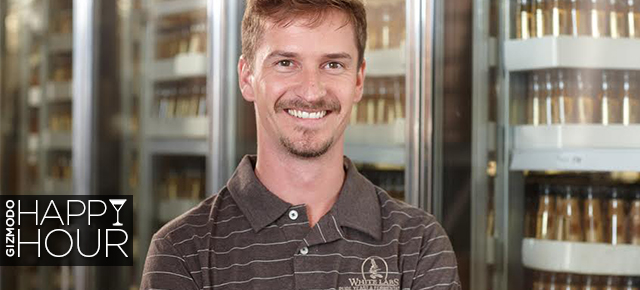Beer may be as old as civilisation itself, but modern molecular biology could teach craft brewers some new tricks. Troels Prahl, a brewer and microbiologist with White Labs, is currently analysing the full DNA sequences of yeast from 2500 batches of beer in hopes of finding the yeast genes that explain why a lager becomes a lager or an ale an ale.
Without yeast, all beer would taste pretty much the same: cloyingly sweet liquid boiled from grain, also known as wort. It’s only when yeast ferments that the flavours (and, of course, alcohol) we know and love finally emerge. The same brew fermented with different yeast might end up cloudy with hints of banana and clove, or crisp and clear and ale-like. “The yeast in the beer is truly what makes it,” says Prahl. Budweiser famously keeps its yeast under armed security.
Perhaps surprisingly, the genomes of the yeast that create drastically different beers are nearly identical. It wasn’t until recently that DNA sequencing became easy or cheap enough to justify studying beer yeast, meaning we could soon understand the genetic basis of, say, a lager versus an ale. “That’s our number one goal,” says Prahl, “how the genetic code is responsible for the flavour profile of the final beer.”
Prahl works out of White Labs, a Californian distributor of yeast for beer and wine. (His father worked in a wine yeast laboratory, so he of course had to get into beer instead.) Another lab in Belgium is working on a similar genealogy for beer yeast. Taken together, these DNA sequencing projects could be the basis of a new frontier in brewing. “In a few years we might be drinking beers that are far different and more interesting than those that currently exist,” the Belgian lab’s director boasted to the New York Times. That sounds lofty, sure, but advances in biology have fundamentally changed how beer tastes before.
How Microbiology Revolutionised Beer 130 Years Ago
Whether you love or hate the sour beer trend (more on that later), you wouldn’t have had much of a choice in the past. All beer was, to varying degrees, sour. They called it the “beer disease,” and the cause was contamination. Today, brewers can add one carefully chosen yeast to sterile wort, but in the old days, they innoculated a new batch with the dregs of the old one — undesirable bacteria and yeast and all. These unwanted microbes made acid, giving the beer a distinct sour note.
Then in 1883, Emil Christian Hansen managed to isolate a single cell of yeast in his lab at the Carlsberg Research Institute in Copenhagen. (Yes, it’s the same Carlsberg of beer.) By serially diluting a solution, he got single cells of yeast that he then grew in sugar-rich wort. Give it time, and you’ve a got pure yeast culture.
“Pure cultures — it absolutely changed everything,” says Prahl. For the first time, brewers could reliably make clean, crisp beer. The yeast Hansen isolated was for a lager, and Carlsberg freely shared its culture with breweries all over Europe. This is, in part, why our beer shelves today are still dominated by lagers. You have it to thank for our beer shelves stocked with Budweisers and Stellas and Heinekens and Red Stripes and… you get the idea.
The Sex Lives of Yeast
You can think of brewing beer as an elaborate history of growing yeast. As with our fruits and vegetables and livestock, we’ve created varieties of yeast that make radically different beers. But unlike macroagriculture, we can’t cross two strains of yeast and breed them. Instead, the yeast that we have, whether it’s perfect for hefeweizen or the just right for an imperial stout, were stumbled upon it by accident.
Yeast can both divide as clones or reproduce sexually, but the latter is a dicey proposition. A precise alignment of genes makes a particular yeast good for a particular beer, and sexual reproduction — in which you randomly shuffle the genes of two yeast — is no guarantee you’ll end up with another good yeast. Plus, getting them to sexually reproduce requires putting the yeast under stress conditions, which can make later brewing problematic.
Beers of the Future
The difficulty — or impossibility, really — or breeding yeast is why understanding the genetics of yeast could be so exciting. There are some 500 aroma compounds in beer, most of them created by yeast in the fermentation process. Sequencing all of those yeast was, really, the easy part, and Prahl now has the more difficult task of sifting through all the data to find the genes that produce a particular ester or fusel alcohol for a desired aroma.
At this point, we can’t avoid talking about genetic modification. Prahl answers carefully when I bring it up. White Labs doesn’t carry any genetically modified yeast in its catalogue, and its current DNA sequencing is all about identifying, not manipulating, genes in yeast. But yeast are routinely genetically modified in yeast, and it’s not hard to imagine someone creating a beer superyeast using genetic tools in the future: Want a beer with higher alcohol content and more cherry notes? Just add this gene.
That said, genetic modification is arguably at odds with the ethos of craft beer. And sour beers, which can be fermented with the natural microflora of a brewery rather than a pure culture, may in part be a romantic reaction against the carefully regimented science of brewing. Science can push the boundaries of beer, but boozy trends (aka what you want to be caught drinking at a party) is ultimately subject the whims of popularity.
